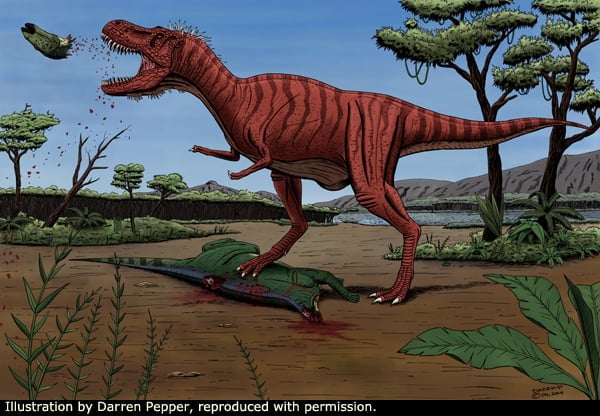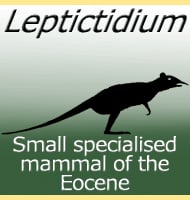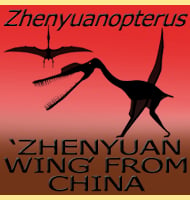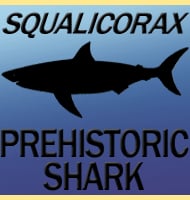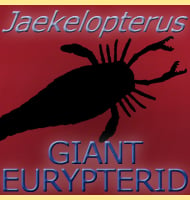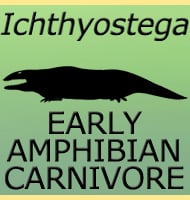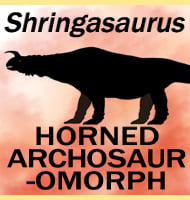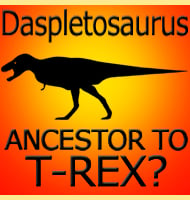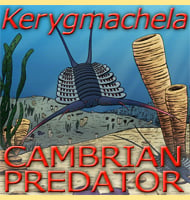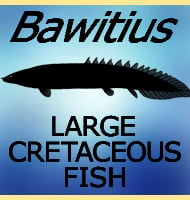Tyrannosaurus rex has been known to science since the end of the nineteenth century, and to this day remains arguably the most popular dinosaur the world over. This is evidenced by its almost mandatory inclusion in books, TV shows, games and websites that are about dinosaurs in general. Tyrannosaurus also probably has more toys and merchandising relating to it than any other dinosaur.
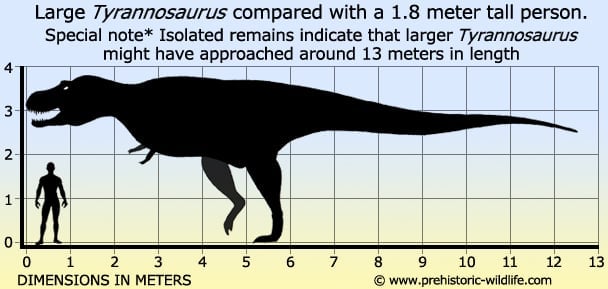
Size and Growth
Although Tyrannosaurus has lost the epithet of largest carnivorous dinosaur to others like Giganotosaurus and Spinosaurus, it still remains the largest from North America, and still sits among the biggest known carnivorous theropods.
The largest recovered specimen of Tyrannosaurus is an 85% complete individual nicknamed ‘Sue’ after its discoverer, and measures a total length of 12.3 meters.
However the largest Tyrannosaurus skull measures 1.5 meters long, bigger than ‘Sue’s’ skull that measures 1.41 meters long. This Skull is 6 per cent bigger than ‘Sue’, and by scaling up ‘Sue’s” body length by the same percentage, gives a potential total body size of up to 13 meters long.
It should be remembered however that the maximum size of Tyrannosaurus, and indeed other extinct creatures, needs to be attributed to fossil material of a size that fits the estimate, otherwise it can only remain as speculation.
Not only is ‘Sue’ 12.3 meters long, study of the fossils has revealed that ‘Sue’ was 28 years old at the time of death. This is considered to be old for a Tyrannosaurus, with maximum age estimates for the genus usually stopping at 30 years old.
It could still be that Tyrannosaurus potentially grew bigger than the confirmed 12.3 meters long by the way it grew up.
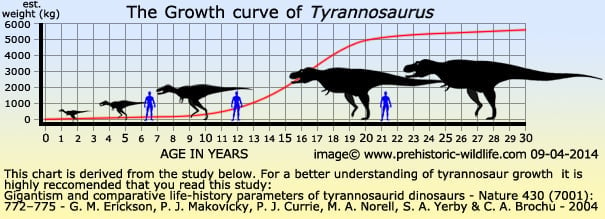
There are a large number of fossils not just for Tyrannosaurus, but for the tyrannosaurid group as a whole, that represent individuals of different ages and their corresponding sizes. When these sizes and ages are put together, an S shaped growth curve is clearly displayed.
This indicates that for roughly the first third of their lives, the tyrannosaurids grew quite slowly, reaching about a tenth of their full potential size. When they became teenagers however, they underwent a massive growth spurt, reaching nearly their full adult size in only about ten years. After this spurt, the rate of growth levels off as dramatically as it began when the individual reaches approximately twenty years of age.
While this is a common trait for the tyrannosaurid group, the rate of growth for Tyrannosaurus is even greater than the smaller tyrannosaurids like Gorgosaurus. This is even more spectacular when you consider that Tyrannosaurus is not thought to have lived any longer than its smaller brethren, but still grew meters longer, and several tons heavier.
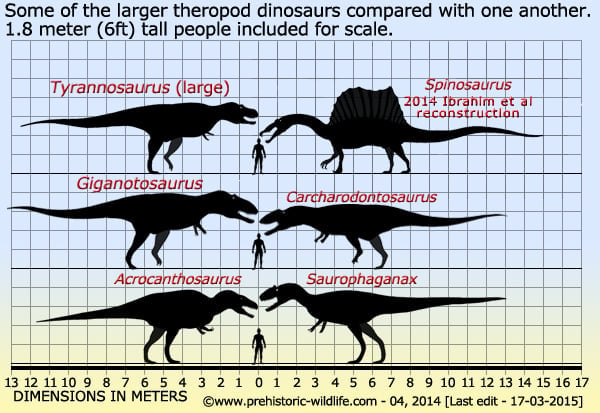
Predator or Scavenger
One of the most controversial theories about Tyrannosaurus is if it was actually a predator at all, but instead lived the life of a scavenger. Some have said that its size, even when combined with lower weight estimates meant that it could not run, as in both feet off the ground at the same time. Biomechanical studies have also shown that it was no way near as fast as it is sometimes depicted in movies.
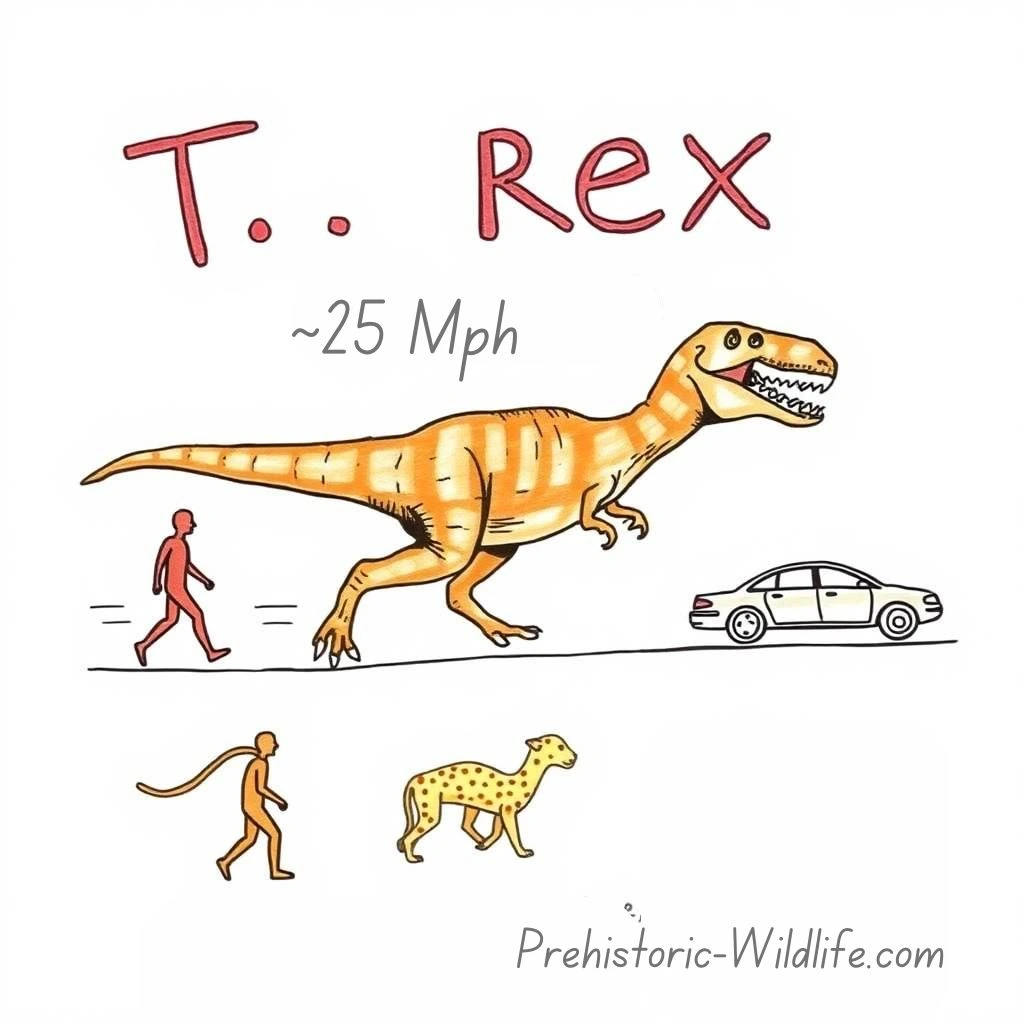
It is popularly said that for a Tyrannosaurus to run at 25 miles per hour, it would need up to of around 80% of its muscle mass in its legs, an unheard of scenario. What are considered more realistic estimates place top speed at around the 11 miles per hour mark.
A slower than expected speed does not mean that Tyrannosaurus was a scavenger however. You have to remember that predators need to be only fast enough to catch their prey. Many of the primary prey species of Tyrannosaurus were hadrosaurs like Edmontosaurus, ceratopsians like Triceratops, and maybe even armoured dinosaurs like Ankylosaurus. These dinosaurs were built for browsing on vegetation, not speed.
Even though hadrosaurs are considered to have been optionally bipedal when the situation arose, and some think that ceratopsian dinosaurs could run fast in a similar fashion to a rhinoceros, if they still could not out run a Tyrannosaurus whether through injury, old age or just inability, they would almost certainly still be on the menu.
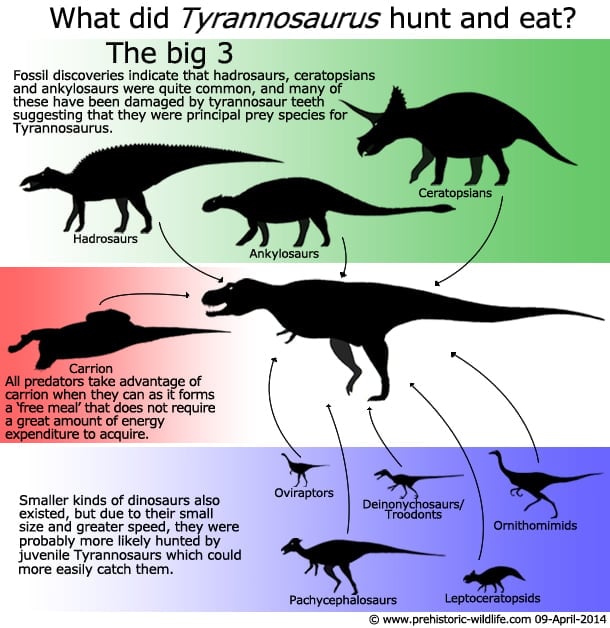
When determining speed, you also have to look at the stride of the animal, or rather, how much distance can it cover when taking a comfortable stride forwards. If Tyrannosaurus could out stride its prey, it would not have to move its leg muscles as often as its prey did, because the mechanical advantage of its longer legs would compensate.
It’s like if you have a compass and open it up to 1 centimetres width between the points. You place the first point on a piece of paper and rotate it 180 degrees so the second point is in front of the first. You then take another ‘step’ by rotating the first point 180 degrees around the second.
‘Stepping’ this way should mean that you need to take 10 steps to clear a straight line of 10 centimetres length. Now if you repeat this, but this time use a 2 centimetre space between the compass points, you can cover the same distance as before with just 5 ‘steps’.
If you get two compasses and set them to different widths, you can see the wider compass gaining and overtaking the smaller when the number of steps is equal.
Of course we all know that animal legs don’t work in the same way as a rotating compass, but the principal of a larger fixed gait gaining ground on a smaller gait still applies. As stated above, a prey animal with a smaller stride than Tyrannosaurus would have to move at a faster rate in order to maintain distance.
In determining top running speed, researchers also look at correlations in different bone sizes.
Animals that are more fleet of foot tend to have lower leg bones (tibia and fibula) that are longer than the upper (femur). In Tyrannosaurus these two areas are roughly the same size as one another, and because of this some have again suggested that Tyrannosaurus was more likely a scavenger as opposed to a running predator. Again however things are not as clear cut as they first seem.
In Tyrannosaurus the metatarsals (foot bones) are not positioned flat as they are in human feet.
They instead form an extension to the lower leg bones, increasing the total length of the lower leg area. This would be like a human being running while balancing on just their toes instead of their whole foot, and would have worked to increase the striding distance of Tyrannosaurus.
This arrangement of foot bones is referred to as digitigrade, and is commonly seen in animals that run after others.
Another thing that supporters of the idea that Tyrannosaurus was a scavenger point to are the proportionately tiny arms. These have long been conceived as being useless for killing or even holding onto prey because of the small size compared to other predatory dinosaurs.
Comparisons have even been drawn between Tyrannosaurus and smaller dromaeosaurid dinosaurs like Velociraptor as proof that Tyrannosaurus could not hunt because it does not have the proportionately longer arms that dromaeosaurid dinosaurs had.
Really though it is not a case of arm length that determines if an animal is an active predator or not, it is how an animal hunts. Dromaeosaurid dinosaurs do have long arms, but they also have smaller heads and comparatively weak bite forces when compared to larger carnivores.
Dromaeosaurid dinosaurs instead probably relied upon the enlarged curved claws that were on their feet and it is generally accepted that they used these claws to stab at their prey.
In order to hit the right weak spots like the necks of their victims, they would have had an easier time of it if they reached up and held onto the prey animal so that they moved with the animal as it struggled to escape, meaning that they would only have to concentrate on moving their legs to strike. In short, dromaeosaurids had longer arms because they were necessary.
Tyrannosaurus did not have specially adapted killing claws on its feet. It did however have a large and massively powerful head that could rival any other of the large theropod dinosaurs.
This head was also carried at a height that would have allowed for easy bites to the back and necks of the larger dinosaurs of its time and location. All Tyrannosaurus would have to do is come up alongside its prey and deliver a single well placed bite to its spine to cripple if not kill its prey instantly.
There is a very good piece of evidence that supports the above hunting strategy for Tyrannosaurus, and this comes from the remains of an Edmontosaurus specimen that shows signs of a Tyrannosaurus attack. Several of the vertebrae show a bite mark created by a Tyrannosaurus, but more importantly the bones show that the wound healed. This proves that the Edmontosaurus was alive when the Tyrannosaurus bit into it. Had it already been dead, the wound would not have healed, although a few centimetres further down and the story would have been very different.
Other scavenger claims include the bone crushing bite and bone fragments found in Tyrannosaurus coprolites. However, many of the potential prey species available to Tyrannosaurus were armoured, and would necessitate the bone crushing teeth.
Also, the type of teeth in the mouth of Tyrannosaurus would mean that flesh would have to be ripped from the carcass, and this process would undoubtedly pull bone free whether Tyrannosaurus intended to or not.
The olfactory senses of Tyrannosaurus were also highly developed, giving it an exceptional sense of smell. This indication could go either way to support the scavenger or hunter theories for Tyrannosaurus as a good sense of smell is a vital part of any carnivorous animal.
At the end of this, almost all predators that kill their own prey will also actively scavenge carcasses as well. It just makes good sense as scavenging requires far less calories than chasing and attacking prey, and does not carry the risk of injury from struggling prey in the process.
Tyrannosaurus biology
The actual non feeding lifestyle and biology of Tyrannosaurus are also subjects of interest. Because the back of the skull was wide in proportion to the tip of the snout, Tyrannosaurus had very good ‘binocular vision’.
This means that it had a good sense of depth perception and knew exactly when another dinosaur was close enough to strike.
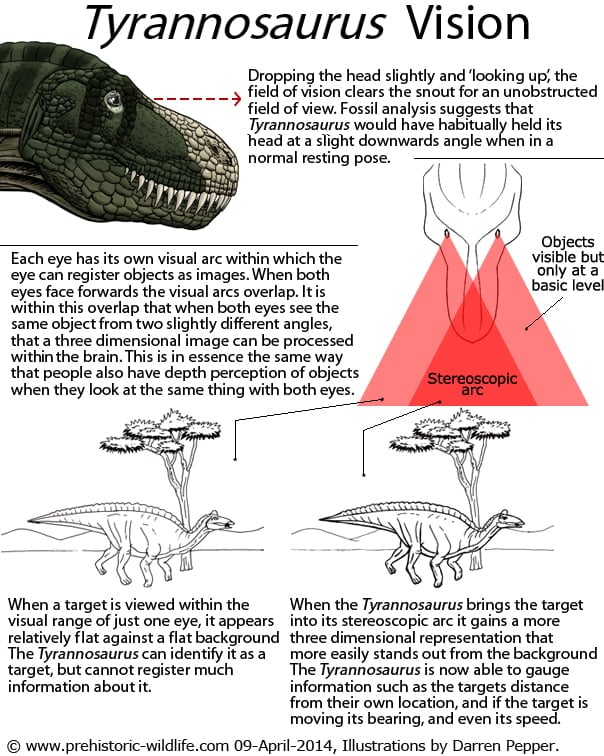
Returning to the arms, although they were small, they were surprisingly powerful.
Biomechanical studies have suggested that the arms could lift up to 200kg, enough to lift almost any human being off the ground. The simple structure of the arms also indicates that they were better suited to provide firm support, and may have been used by Tyrannosaurus to grip another as they mated.
While the arms do seem to have served some purpose in the life of Tyrannosaurus, it has caused a lot of wonder as to what would have happened to them had the dinosaurs not gone extinct at the end of the Cretaceous.
Earlier members of the group like Eotyrannus had proportionately longer arms than Tyrannosaurus, and the study of group shows that as tyrannosaurids grew bigger, the arms got shorter. Some think that given enough time, the arms may have disappeared almost completely, like whales losing the hind limbs that were present in their quadrupedal ancestors. Unfortunately, we will probably never be certain of the answer.
The jaws of Tyrannosaurus were tremendously powerful with a bite force of larger individuals being measured in several tons. The teeth were primarily arranged into biting incisors at the front, with larger canines to the size and rear of the mouth.
The incisors that are on the premaxilla form a ‘D shaped’ curve around the front, which is notable as this gave Tyrannosaurus (and others of its group) a ‘U shaped’ snout. Other well-known carnivorous theropods such as Allosaurus were more ‘V shaped’. The ‘U’ shaped snout means that Tyrannosaurus had more ‘pick-up’ every time it took a bite than other dinosaurs. The teeth towards the sides of the mouth were the most suited to crushing, and grow anywhere up to 30 centimetres long when including the root.
The teeth of the lower jaw (mandible) were smaller than those above, and fitted inside the upper jaw so that when closed, only the upper teeth would protrude out and downwards.
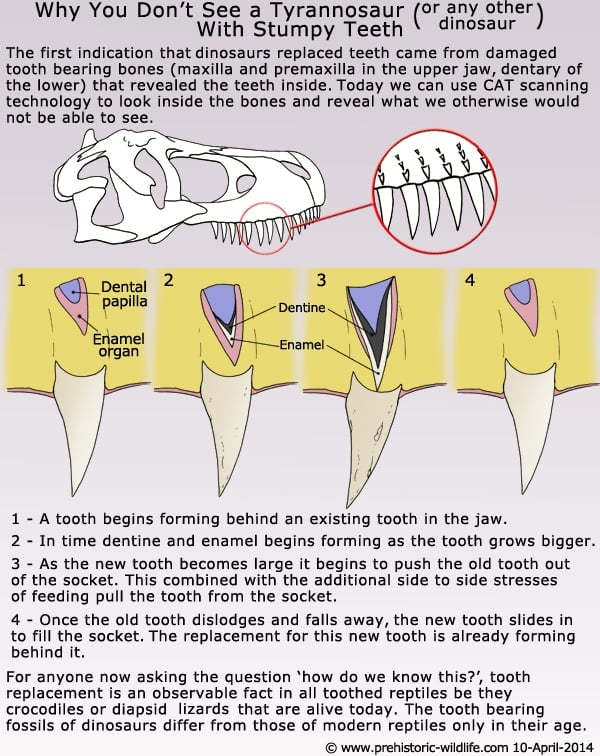
Tyrannosaurus like so many of the other early discovered dinosaurs was once considered to be a cold blooded and sluggish until warmed up in the sun creature. Yet as a large theropod, Tyrannosaurus can actually present a case for a warm blooded metabolism through gigantothermy. This is where the surface area of the animal is small when compared to the volume and mass of the animal.
A smaller surface area results in a reduced area for heat to escape out of the body. This in turn raises the base temperature of the animal beyond what it would be if it were the same size but with a much thinner build.
The rapid growth curve exhibited in Tyrannosaurids as a whole can also be considered indicative of a warm blooded metabolism, as animals that are cold blooded tend to have a more stable and constant rate of growth until they are full grown.
It has also been put forward that when very young, Tyrannosaurus may have had some feather growth as insulation on its body. This is based upon the discovery that some of the basal and smaller tyrannosaurids like Dilong have been found with the impressions of protofeathers with their remains.
However what is known for fact is that as an adult, Tyrannosaurus would have almost certainly had no feathers at all, with skin impressions of an adult Tyrannosaurus revealing that it had a bare pebble like texture to it.However, ever since the description of Yutyrannus in 2012, the notion that large tyrannosaurs may have had at least a partial feather covering has now been seriously reconsidered.
Tyrannosaurus remains can be divided into two groups of robust (larger and heavier) and gracile (smaller and lighter) forms. For a long time it was believed that these represented male and female specimens with the larger ones presumably being female to allow for egg development inside of the hips. Problems would eventually arise with this thinking however.
It was also thought that females had a reduced chevron in the first caudal (tail) vertebra to allow for the passage of eggs. However, comparison between remains show that first caudal vertebrae with a fully developed chevron are also present in the robust (and once presumed female) morphs.
This means that the two morphs can no longer be relied upon to tell the differences between male and female, and are now instead considered to represent older individuals for the robust morphs, younger for the gracile morphs. They may even be representative of Tyrannosaurus populations hailing from different geographical areas.
Although telling the difference between male and female Tyrannosaurus is now more problematic, one specimen can be confirmed as being absolutely 100% female. This is because of the presence of what is called medullary tissue in the fossilised remains.
In birds this tissue is a kind of a calcium reserve that is used for the production of eggshells during ovulation. Because it is used for this process, it obviously only occurs naturally in female birds, and by extension, could only exist in female Tyrannosaurus as they are the ones that would have laid the eggs, not the males.
Remnants of medullary tissue have also been found in some other dinosaurs, and since its initial discovery in fossils, its presence has been actively sought out in other specimens. The existing medullary tissue found is taken as further evidence for the support for the theory that birds evolved from dinosaurs.
An exciting discovery about Tyrannosaurus biology came about in 2005 when a femur was broken to facilitate transportation. Inside were the remains of fibrous bone matrix tissue and blood vessels. It has long been presumed that soft tissue is incompatible with the known forms of fossilisation, but this has been seen as evidence that it is on certain occasions possible to a certain extent. This discovery has also helped lead to other fossils being tested for the presence of soft tissue.
Further study on soft tissue has led to analysis of collagen proteins from the inner parts of the collagen coil, with results showing that they closely match those of modern day chickens. Again this has reinforced the theory that dinosaurs are indeed more closely related to birds.
Tyrannosaurus interaction
Although there is some evidence to suggest pack hunting in some tyrannosaurs like Albertosaurus and Yutyrannus, there is none present for Tyrannosaurus itself. Some Tyrannosaurus skulls bear marks that are considered by some to have been caused by the teeth of another Tyrannosaurus.
This would bring in potential intraspecific biting that is seen in some carnivores as signs of a dominance struggle. If true, this could present a scenario where a Tyrannosaurus challenged another in conflict over a carcass, resulting in the bite marks to the face.
However, a later theory is that these marks were not caused by another Tyrannosaurus, but a parasite similar to one that belongs to the genus Trichomonas, a protist parasite that is known to affect birds today. These parasites cause growths in the soft tissue that can also scar the bone underneath.
Infection could have been caused quite easily when a Tyrannosaurus drunk from water where Trichomonas was active, possibly left there by another infected dinosaur.
A study undertaken in 2010 has brought forward the suggestion of cannibalism in Tyrannosaurus. This comes from what appear to be strong tooth marks to the legs and feet of a Tyrannosaurus specimen.
It is thought that this individual was already dead when eaten because in a living Tyrrannosaurus, the lower legs would have been the furthest points away from the mouth of another Tyrannosaurus, making them very hard to reach and not really viable targets when you consider that the head and neck would be much easier to grab hold of. It is not certain however if this Tyrannosaurus had been eaten by the other that killed it, or if it died from some other cause.
Also these body parts have some of the smallest amounts of muscle mass, further indicating the Tyrannosaurus that was doing the eating had found a carcass that had already been picked clean of the choice pieces of flesh.
Tyrannosaurus rex or Manospondylus gigas?
Technically, Tyrannosaurus is not the original name for this dinosaur. In 1892, Edward Drinker Cope named two incomplete vertebrae that he thought were from a ceratopsian dinosaur.
He named the new dinosaur as Manospondylus gigas, which translates to English as ‘giant porous vertebra’. Although lacking in completeness, the bones were unknown and considered enough to warrant a genus name.
What needs to remembered is that this naming took place towards the end of the ‘Bone wars’, a fierce rivalry between cope and Othniel Charles Marsh that included who could name the most species. Today, a naming for such scant material would be done only after very careful consideration on the part of the researchers.
In 1905, Henry Fairfield Osborn named what was considered the first specimen of Tyrannosaurus that was originally dug up by Barnum Brown in 1902. In a 1917 paper Osborn discussed many dinosaurs, but also noted the similarity between the vertebra of Tyrannosaurus and Manospondylus. Despite these similarities being pointed out, nothing further happened until the turn of the following century.
In the year 2000, the Black Hills Institute of Geological Research found what is believed to be the original fossil site for Manospondylus gigas. There, the dig crew recovered further Tyrannosaurus remains confirming that the Manospondylus remains did indeed belong to Tyrannosaurus.
This presented immediate upset not just in the paleontological community but in news reports around the world. Typically under ICZN rules, the first name has priority of any subsequent names that are given to the same genus. In this scenario, Tyrannosaurus would only exist as a synonym, and all fossils and future references to Tyrannosaurus would have to say Manospondylus instead.
However a revision to ICZN rules that happened a little earlier in 2000 may actually preserve the name Tyrannosaurus. The simplest version of these revisions come across as any junior synonym (in this case Tyrannosaurus) that has been used as the accepted name for a species instead of the senior name (Manospondylus) that was granted before 1899, may be used as the official name for that taxon.
This means that Tyrannosaurus is likely going to remain known as Tyrannosaurus because of so many studies published by so many palaeontologists referring to it as Tyrannosaurus. In contrast, Manospondylus is virtually unknown if you don’t count the very scant references to its similarity with Tyrannosaurus, and as such will become treated in a similar manner to any other synonym to Tyrannosaurus.
Tyrannosaurus, Tarbosaurus and other suggested synonyms
Scant remains of tyrannosaurs such as teeth and the occasional post cranial bone were being found during the late nineteenth century, but it was not until 1905 when the first Tyrannosaurus specimen was described that people had an idea what they were dealing with. This is why Tyrannosaurus has been used to name the groups Tyrannosauoirdea, Tyrannosauridae and Tyrannosaurinae, there was enough left of this genus to identify remains of other similar dinosaurs as tyrannosaurs. Before the term tyrannosaur came into use however, tyrannosaurs were known as deinodonts after the genus Deinodon (‘terrible tooth’), but like with many of the genera established before the description of Tyrannosaurus, it was based mostly on teeth, which means that it would be incredibly difficult to attribute skeletal remains to the genus with certainty.
In 1955 an expedition in Mongolia recovered the remains of a huge tyrannosaur that bore a superficial resemblance to Tyrannosaurus, and even today, if you only took a quick glance at the side view of these fossils you would be hard pressesd to spot a clear difference.
The palaeontologist Evgeny Maleev described these remains as a new species of Tyrannosaurus, T. bataar, though almost immediately there was some concern about whether this was the right interpretation.
Ten years later in 1965 Tyrannosaurus bataar was renamed Tarbosaurus bataar, and from then on there has been a nearly constant debate over how to keep the fossils named, as a species of Tyrannosaurus or the new genus Tarbosaurus.
Most studies concerning these two tyrannosaurs have centred on finding differences and similarities between them, but what defines enough differences to registers a new species or a new genus can vary greatly amongst researchers. While the skulls of Tyrannosaurus and Tarbosaurus are quite similar when seen from the side, when viewed from the front or above it becomes immediately clear that the skull of Tarbosaurus is far narrower than the skull of Tyrannosaurus.
Further analysis has also shown that the way that stresses are transmitted through the skull is very different in Tarbosaurus.
Tarbosaurus was once widely accepted as the sister taxon to Tyrannosaurus, but bringing other genera into the equation this is no longer the case. Another tyrannosaur from Mongolia that was once considered to be a juvenile Tarbosaurus is Alioramus.
Studies and new fossils of Alioramus now not only confirm that it is indeed a distinct genus, but that it is actually closer to Tarbosaurus than what Tyrannosaurus is, something that suggests no immediate familial link between Tarbosaurus and Tyrannosaurus other than they were both tyrannosaurs.
The discovery of the genus Lythronax in North America has also indicated that the tyrannosaurids were present their long before the appearance of either Tyrannosaurus in North America or Tarbosaurus in Asia. Today, most palaeontologists agree that it is a better idea to keep Tyrannosaurus and Tarbosaurus as separate genera, especially as more studies and new remains point more to this conclusion.
For a long time now there has been a ‘big four’ tyrannosaur genera in North America which would have lived in upper Laramidia at the end of the Cretaceous. These are Tyrannosaurus, Daspletosaurus, Albertosaurus and Gorgosaurus, the latter three of which occasionally get treated as synonyms.
Albertosaurus and Gorgosaurus are quite different to Tyrannosaurus in that they are more lightly built. Gorgosaurus is frequently synonymised with Albertosaurus too, yet at this time Gorgosaurus is still regarded as valid by many.
Albertosaurus is and by extension Gorgosaurus are perhaps the least likely to ever be synonymised to Tyrannosaurus due to their obviously lighter builds. Daspletosaurus is more robust like Tyrannosaurus, but so far known from slightly earlier in the Cretaceous.
Some continue to treat Daspletosaurus as a synonym to Tyrannosaurus, though most choose to keep the genus separate. In addition to this, some people consider Daspletosaurus to be the genus that is directly ancestral to the Tyrannosaurus genus.
Further Reading
- Tyrannosaurus and other Cretaceous carnivorous dinosaurs – Bulletin of the AMNH – Henry Fairfield Osborn – 1905.
- Tyrannosaurus, Upper Cretaceous carnivorous dinosaur – Bulletin of the AMNH (New York City: American Museum of Natural History) 22 (16): 281–296 – Henry Fairfield Osborn & Barnum Brown – 1906.
- Skeletal adaptations of Ornitholestes, Struthiomimus, Tyrannosaurus”. Bulletin of the American Museum of Natural History (New York City: American Museum of Natural History) 35 (43): 733–771 – Henry Fairfield Osborn – 1917.
- [Gigantic carnivorous dinosaurs of Mongolia], E. A. Maleev (translated by F. J. Alcock) – Doklady Akademii Nauk SSSR – 1955.
- Growth changes in Asian dinosaurs and some problems of their taxonomy – Paleontological Journal 3: 95–109. – A. K. Rozhdestvensky – 1965.
- Stance and gait in the flesh-eating Tyrannosaurus – Biological Journal of the Linnean Society 2 (2): 119–123 B. H. Newman – 1970.
- Tiny dinosaurs: Are they fully grown? – Journal of Vertebrate Paleontology 3 (4): 200–209. – G. Callison & H. M. Quimby – 1984.
- Long bone circumference and weight in mammals, birds and dinosaurs – Journal of Zoology 207 (1): 53–61 – J. F. Anderson, A. J. Hall-Martin & D. A. Russel – 1985. – Nanotyrannus, a new genus of pygmy tyrannosaur, from the latest Cretaceous of Montana – Hunteria 1 (5): 1–30 – R. T. Bakker, M. Williams & P. J. Currie – 1988.
- Variation in Tyrannosaurus rex, Kenneth Carpenter – In Kenneth Carpenter and Philip J. Currie. Dinosaur Systematics: Approaches and Perspectives. Cambridge: Cambridge University Press. pp. 141–145 – 1992.
- The serrated teeth of tyrannosaurid dinosaurs, and biting structures in other animals – Paleobiology18 (2): 161–183 – Abler William – 1992.
- Steak knives, beady eyes, and tiny little arms (a portrait of Tyrannosaurus as a scavenger) – The Paleontological Society Special Publication 7: 157–164 – J. R. Horner – 1994.
- The Phylogenetic Position of the Tyrannosauridae: Implications for Theropod Systematics – Journal of Palaeontology 68 (5): 1100–1117 – Thomas R. Holtz – 1994.
- A track of the giant theropod dinosaur Tyrannosaurus from close to the Cretaceous/Tertiary boundary, northern New Mexico – Ichnos 3 (3): 213–218. – M. G. Lockley & A. P. Hunt – 1994.
- Thermophysiology of Tyrannosaurus rex: Evidence from Oxygen Isotopes – Science (New York City) 265 (5169): 222–224 – Reese E. Barrick & William J. Showers – 1994.
- Body mass, bone “strength indicator”, and cursorial potential of Tyrannosaurus rex – Journal of Vertebrate Paleontology 15 (4): 713–725 – J. O. Farlow, M. B. Smith & J. M. Robinson – 1995.
- Bite-force estimation for Tyrannosaurus rex from tooth-marked bones – Nature 382 – G. M. Erickson, S. D. Van Kirk, J. Su, M. E. Levenston, W. E. Caler & D. R. Carter – 1996.
- Head-biting behavior in theropod dinosaurs: paleopathological evidence – Gaia (15): 167–184 – Darren H. Tanke & Phillip J. Currie – 1998.
- Strength indicator values of theropod long bones, with comments on limb proportions and cursorial potential – Gaia 15: 241–255 – P. Christiansen – 1999.
- Estimating the masses and centers of mass of extinct animals by 3-D mathematical slicing – Paleobiology 25 (1): 88–106 – Donald M. Henderson – 1999.
- Craniofacial ontogeny in Tyrannosauridae (Dinosauria, Theropoda) – Journal of Vertebrate Paleontology 19 (3): 497–520. – T. D. Carr – 1999.
- Thermophysiology and biology of Giganotosaurus: comparison with Tyrannosaurus – Palaeontologia Electronica 2 – Reese E. Barrick & William J. Showers – 1999.
- Limb design, function and running performance in ostrich-mimics and tyrannosaurs – Gaia 15: 257–270 – Gregory S. Paul – 2000.
- A new method to calculate allometric length–mass relationships of dinosaurs – Journal of Vertebrate Paleontology 21 (1): 51–60 – Frank Seebacher – 2001.
- Forelimb Osteology and Biomechanics of Tyrannosaurus rex, Kenneth Carpenter & Matt Smith – In Darren Tanke & Kenneth Carpenter, Mesozoic vertebrate life. Bloomington: Indiana University Press. pp. 90–116 – 2001.
- Tyrannosaurus was not a fast runner – Nature 415 (6875): 1018–21 – J. R. Hutchinson & M. Garcia – 2002.
- Maximum bite force and prey size of Tyrannosaurus rex and their relationships to the inference of feeding behavior – Historical Biology: A Journal of Paleobiology 16 (1): 1–12 – Mason B. Meers – 2003.
- Diagenetic effects on the oxygen isotope composition of bones of dinosaurs and other vertebrates recovered from terrestrial and marine sediments – Journal of the Geological Society 160 (6): 895 – Clive Trueman, Carolyn Chenery, David A. Eberth & Baruch Spiro – 2003.
- Giant theropod dinosaurs from Asia and North America: Skulls of Tarbosaurus bataar and Tyrannosaurus rex compared – Acta Palaeontologica Polonica 48 (2): 161–190 – J�rn H. Hurum & Karol Sabath – 2003.
Could Tyrannosaurus rex have been a scavenger rather than a predator? An energetics approach – Proceedings. Biological sciences the Royal Society 270 (1516): 731–3 – G. D. Ruxton & D. C. Houston – 2003. - Osteology of Tyrannosaurus rex: insights from a nearly complete skeleton and high-resolution computed tomographic analysis of the skull – Society of Vertebrate Paleontology Memoirs 7: 1–138 – C. R. Brochu – 2003.
- Cranial anatomy of tyrannosaurid dinosaurs from the Late Cretaceous of Alberta, Canada – Acta Palaeontologica Polonica 42 (2): 191–226. – Phillip J. Currie – 2003.
- Skull structure and evolution in tyrannosaurid dinosaurs – Acta Palaeontologica Polonica 48 (2): 227–234. – Philip J. Currie, J�rn H. Hurum & Karol Sabath – 2003.
- Diversity of late Maastrichtian Tyrannosauridae (Dinosauria: Theropoda) from western North America – Zoological Journal of the Linnean Society 142 (4): 479–523 – T. D. Carr & T. E. Williamson – 2004.
- Obligate vertebrate scavengers must be large soaring fliers – Journal of Theoretical Biology 28 (3): 431–436 – Graeme D. Ruxton & David C. Houson – 2004.
- Gigantism and comparative life-history parameters of tyrannosaurid dinosaurs – Nature 430 (7001): 772–775 – Gregory M. Erickson, Peter J.Makovicky, Philip J. Currie, Mark A. Norell, Scott A. Yerby & Christopher A. Brochu – 2004.
- Mass prediction in theropod dinosaurs – Historical Biology 16 (2–4): 85–92 – Per Christiansen & Richard A. Fari�a – 2004.
- Age and growth dynamics of Tyrannosaurus rex – Proceedings. Biological sciences / the Royal Society 271 (1551) – J. R. Horner & K. Padian – 2004.
- Soft-tissue vessels and cellular preservation in Tyrannosaurus rex – Science 307 (5717): 1952–5 – Mary H. Schweitzer, Jennifer L. Wittmeyer, John R. Horner & Jan K. Toporski – 2005.
- Gender-specific reproductive tissue in ratites and Tyrannosaurus rex – Science 308 (5727): 1456–60 – M. H. Schweitzer, J. L. Wittmeyer & J. R. Horner – 2005.
- In Celebration of 100 years of Tyrannosaurus rex: Manospondylus gigas, Ornithomimus grandis, and Dynamosaurus imperiosus, the Earliest Discoveries of Tyrannosaurus Rex in the West – Abstracts with Programs. 2005 Salt Lake City Annual Meeting 37 (7). Geological Society of America. p. 406 – Brent H. Breithaupt, Elizabeth H. Southwell & Neffra A. Matthews – 2005.
- Heterodonty in Tyrannosaurus rex: implications for the taxonomic and systematic utility of theropod dentitions – Journal of Vertebrate Paleontology 25 (4): 865–887 – J. B. Smith – 2005.
- Binocular vision in theropod dinosaurs – Journal of Vertebrate Paleontology 26 (2) – Kent A. Stevens – 2006.
- Fused and vaulted nasals of tyrannosaurid dinosaurs: Implications for cranial strength and feeding mechanics – Acta Palaeontologica Polonica 51 (3): 435–454. – Eric Snively, Donald M. Henderson & Doug S. Phillips – 2006.
- Dynamosaurus imperiosus and the earliest discoveries of Tyrannosaurus rex in Wyoming and the West – New Mexico Museum of Natural History and Science Bulletin 35: 257–258 – B. H. Breithaup, E. H. Southwell & N. A. Matthews – 2006.
- Tyrannosaur life tables: an example of nonavian dinosaur population biology – Science 313 (5784): 213–7 – G. M. Erickson, P. J. Currie, B. D. Inouye & A. A. Winn – 2006.
- A 3D interactive method for estimating body segmental parameters in animals: application to the turning and running performance of Tyrannosaurus rex – Journal of Theoretical Biology 246 (4): 660–80 – John R. Hutchinson, Victor Ng-Thow-Hing & Frank C. Anderson – 2007.
- Estimating dinosaur maximum running speeds using evolutionary robotics – Proc. R. Soc. B (The Royal Society) 274 (1626): 2711–6 – W. I. Sellers & P. L. Manning – 2007.
- Craniocervical feeding dynamics of Tyrannosaurus rex – Paleobiology 33(4): 610-638 – Eric Snively & Anthony P. Russel – 2007.
- Tyrannosaurus rex, the Tyrant King (Life of the Past). Bloomington: Indiana University Press. ISBN 0-253-35087-5, Kenneth Carpenter & Peter E. Larson – 2008.
- Sexual maturity in growing dinosaurs does not fit reptilian growth models – Proceedings of the National Academy of Sciences 105 (2): 582–587 – Andrew H. Lee & Sarah Werning – 2008.
- Looking again at the forelimb of Tyrannosaurus rex”. In Carpenter, Kenneth; and Larson, Peter E. (editors), Tyrannosaurus rex, the Tyrant King (Life of the Past). – Bloomington: Indiana University Press – Christine Lipkin, & Kenneth Carpenter – 2008.
- Dinosaurian Soft Tissues Interpreted as Bacterial Biofilms – In Stepanova, Anna. PLoS ONE 3 (7): e2808 – Thomas G. Kaye, Gary Gaugler & Zbigniew Sawlowicz – 2008.
- New insights into the brain, braincase, and ear region of tyrannosaurs (Dinosauria, Theropoda), with implications for sensory organization and behavior. – The Anatomical Record 292(9) 1266-1296 – Lawrence M. Witmer & Ryan C. Ridgely – 2009.
- Common Avian Infection Plagued the Tyrant Dinosaurs – In Hansen, Dennis Marinus. PLoS ONE 4 (9): e728, – E. D. S. Wolff, S. W. Salisbury, J. R. Horner & D. J. Varricchi – 2009.
- Face Biting On A Juvenile Tyrannosaurid And Behavioral Implications – Palaios 24 (11): 780–784 – Joseph E. Peterson, Michael D. Henderson & Reed P. Sherer & Christopher P. Vittore – 2009.
- Cannibalism in Tyrannosaurus rex – Public Library of Science. – N. R. Longrich, J. R. Horner, G. M. Erickson & P. J Currie – 2010.
- The Tail of Tyrannosaurus: Reassessing the Size and Locomotive Importance of the M. caudofemoralis in Non-Avian Theropods – The Anatomical Record: Advances in Integrative Anatomy and Evolutionary Biology 294 (1): 119–131 – Scott W. Persons & Phillip J. Currie – 2010/2011.
- A Computational Analysis of Limb and Body Dimensions in Tyrannosaurus rex with Implications for Locomotion, Ontogeny, and Growth – PLoS ONE 6 (10): e26037 – J. R. Hutchinson, K. T. Bates, J. Molnar, V. Allen, P. J. Makovicky – 2011.
- Tyrannosaurs were power-walkers – Nature – Matt Kaplan – 2011.
- Dinosaur Census Reveals Abundant Tyrannosaurus and Rare Ontogenetic Stages in the Upper Cretaceous Hell Creek Formation (Maastrichtian), Montana, USA – PLoS ONE 6 (2): e16574 – John R. Horner, Mark B. Goodwin & Nathan Myhrvold – 2011.
- Estimating maximum bite performance in Tyrannosaurus rex using multi-body dynamics – Biological Letters – K. T. Bates & P. L. Falkingham – 2012.
- Tyrant Dinosaur Evolution Tracks the Rise and Fall of Late Cretaceous Oceans – In Evans, David C. PLoS ONE 8 (11) – M. A. Loewen, R. B. Irmis, J. J. W. Sertich, P. J. Currie & S. D. Sampson – 2013.
- The Posture of Tyrannosaurus rex: Why Do Student Views Lag Behind the Science? – Journal of Geoscience Education 61: 145 – R. M. Ross, D. Duggan-Haas & W. D. Allmon – 2013.
- Physical evidence of predatory behavior in Tyrannosaurus rex. – Proceedings of the National Academy of Sciences – Robert A. DePalma II, David A. Burnham, Larry D. Martin, Bruce M. Rothschild & Peter L. Larson – 2013.
- Skin pathology in the Cretaceous: Evidence for probable failed predation in a dinosaur – Cretaceous Research , 42(0),44-47 – Bruce M. Rothschild & Robert DePalma – 2013.
- Chemistry supports the identification of gender-specific reproductive tissue in Tyrannosaurus rex. – Scientific Reports. 6 (23099). – M. H. Schweitzer, W. Zheng, L. Zanno, S. Werning & T. Sugiyama – 2016.
- The biomechanics behind extreme osteophagy in Tyrannosaurus rex. – Scientific Reports. 7 (1): 2012. – P. M. Gignac & G. M. Erickson – 2017.
- Tyrannosauroid integument reveals conflicting patterns of gigantism and feather evolution. – Biology Letters. 13 (6): 20170092. – P. R, Bell, N. E. Campione, W. S. Persons IV, P. J. Currie, P. L. Larson, D. H. Tanke & R. T. Bakker – 2017.
- Investigating the running abilities of Tyrannosaurus rex using stress-constrained multibody dynamic analysis. – PeerJ. 5: e3420. – W. I. Sellers, S. B. Pond, C. A. Brassey, P. L. Manning & K. T. Bates – 2017.
- Lower rotational inertia and larger leg muscles indicate more rapid turns in tyrannosaurids than in other large theropods”. PeerJ. 7: e6432. – Eric Snively, Haley O’Brien, Donald M. Henderson, Heinrich Mallison, Lara A. Surring, Michael E. Burns, Thomas R. Holtz, Jr, Anthony P. Russell, Lawrence M. Witmer, Philip J. Currie, Scott A. Hartman & John R. Cotton – 2019.
- Feeding traces attributable to juvenile Tyrannosaurus rex offer insight into ontogenetic dietary trends. – PeerJ. 7: e6573. – Joseph E. Peterson & Karsen N. Daus – 2019.
- An Older and Exceptionally Large Adult Specimen of Tyrannosaurus rex. – The Anatomical Record. 303 (4): 656–672. – S. W. Persons, P. J. Currie & G. M. Erickson – 2020.
- Growing up Tyrannosaurus rex: Osteohistology refutes the pygmy “Nanotyrannus” and supports ontogenetic niche partitioning in juvenile Tyrannosaurus. – Science Advances. 6 (1). – Holly N. Woodward, Katie Tremaine, Scott A. Williams, Lindsay E. Zanno, John R. Horner & Nathan Myhrvold – 2020.
- Tracks in the upper cretaceous of the raton basin possibly show tyrannosaurid rising from a prone position. – New Mexico Museum of Natural History and Science: 29–37. – T. Canner, T. Molkestad & S. G. Lucas – 2021.
